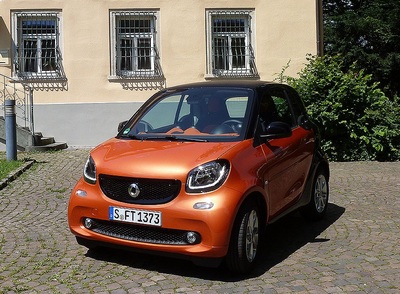First Drive Review: 2016 smart fortwo and 2016 smart forfour By Henny Hemmes
By Henny Hemmes
Senior European Editor
The Auto Channel
STUTTGART, Germany - July 4, 2015: The new smart models made their world
debut at the 2014 Paris motor show, but Smart would not have been smart if
the North American and Chinese shows had not also been used for the
national debuts in great style.
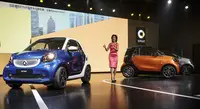 |
In fact, that is one of the important features of the small two-seater, which made its first appearance in.1998.
Tilo Deichl, responsible for development said: “We thought to have developed a car for young people.” But in the more than one and a half decade of its existent this has proven to be quite different and it has reached a very diverse group of customers, young and old(er)/
Since its introduction in 1998, more than 1.6 million units of the Fortwo have been sold worldwide. From the start the micro car was only available in Europe and Canada. It lasted until 2006 for North America to get the second generation, which was introduced in China in 2009.
In only five years, China has become the second largest market after Germany. The new Fortwo will be on the market there as from early August, followed by the Forfour in the beginning of 2016.
The Fortwo will make its first appearance on American soil in a week or so, when it arrives in San Francisco for the first drive event for the media. Early September, the 2016 model will reach the American showrooms.
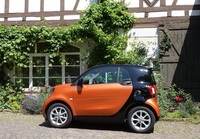 |
The new Fortwo is as short as before, just 2.70 m or 106 inches, but
the width has been increased by 10 cm/4,5 inches. This does not change the
car’s image at all. It is as cute and trendy as before, but it has
instantly become more serious and even offers a bit of driving fun.
Unchanged is the set up, with the engine in the rear, rear wheel drive and
the extra room for the front wheels, which allows for a very short turning
circle.
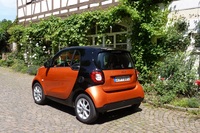 |
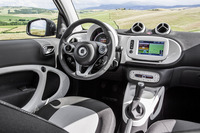 |
Smart offers three variants of Renault’s 1.5-liter three-cylinder engine: 45 kW/61 hp, 52 kW/71 hp and 66 kW/90 hp. They are combined with a 5-speed manual transmission for the first time. It replaces the automated manual transmission of the first and second generations, which was really jerky. But that is behind us now and the new Renault gearbox suits the new Smart fine. It may not be shifting as butter smooth as we are used to in some of the small Japanese models, but it is well geared to work together with the 1.0-liter 3-cilinder engines. The 66 kW models can also be combined with Smart’s own DCT (dual clutch transmission) ‘twinamic’ automatic transmission. Last week, I also drove the new DCT models in and around Cologne.. (>>>> LINK)
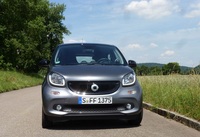 2016 smart forfour |
When I drove the 91 hp Fortwo and later the Forfour on the Autobahn, they proved to be swift enough to go with the traffic. Because the small 3-cylinder engine needs just over 10 seconds to accelerate from 0-62 mph, you may sometimes need some distance between the car in front of you and yourself to be able to accelerate as soon as you start riving on the entrance of the freeway. If needed, you can stay there to the very end to build up speed and safely merge. I felt no reason to do so, as the traffic around Stuttgart was limited to 62 mph and I could easily move in. The basic model would take 15.6 seconds, but I think that most people will opt for the somewhat ‘bigger’ engines that offer 71 or 91 hp. Top speed is 151 km/h and 155 km/h respectively, but it never has been a strong point of the Smart. Logically because it is really meant as a city car.
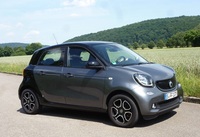 2016 smart forfour |
Thanks to the extended wheelbase the comfort is as good as of their competitors such as the Volkswagen Up or Kia Picanto, while the Forfour offers a good amount of driving pleasure with precise and direct steering. With the 91 hp turbo engine it even feels sporty.
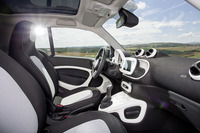 2016 smart forfour |
Even with the engine in the back, the Fortwo offers 350 liters/ 12.36 cu.ft of luggage space. As before, there is no room behind the seats.
The Forfour offers 185-975 liter/6.4-34.4 cu-ft of luggage space. However, there are no plans to offer the four-door model in North America.
Co-operation with Renault
The new Smart Forfour has been jointly developed by Renault and Daimler: the latter developed the platform and Renault developed the drive line. When I asked Mr. Deichl about his experience with working together with the French, he said that the cooperation is beneficial for both companies.
“We have learned from each other, and working together went very well.” When asked if this may be because Renault is used to a different culture (Nissan), he reminded me of the fact that Smart also has such experience when they jointly developed the first four-door model with Mitsubishi, resulting in the 2006 Smart Forfour and Mitsubishi Colt. Both models were built in the plant in The Netherlands, were now the Mini hatch is produced.
“Renault knows how to build small cars and they were looking for an architecture like ours for developing their new generation Twingo small four-door “, Mr. Deichl said, “while we have a lot of experience with the use of customized body parts and a convertible construction.” I believe that with the new ForTwo and Forfour, he is proven right.
Smart has already quite some success with the new generation and will no doubt continue the stylish alternatives for two-wheel transportation and competing four-door models, and of course public transport. Here are lots of ways to individualize the cars with their smart body panels in a lot of different colors. In that aspect, Smart has adapted to the growing trend, formerly there were only four colors of body panels available. Today there are some 4,200 possibilities and that is without taking into consideration all kind of different wheels.
In the US, the base prize for the Smart Fortwo is $ 14,650 (msrp), which means an improvement over the predecessor because of the extended standard equipment. That includes now power windows, power steering, smart radio incl. CD-player and Bluetooth for hands free calls and audio streaming, cruise control, alarm system, 3-spoke multi-function steering wheel, Color display in instrument cluster, additional instruments (tach/clock), LED daytime running lights and Crosswind Assist. There are three packages, Passion, Prime and Proxy and the DCT twinamc transmission that will add 990 dollars to the cost.
The smart fortwo will be available in the US in Q4 of this year, while the forfour will not reach North America.
The Most In-Depth smart Vehicle Shopper's Research - Anywhere!



